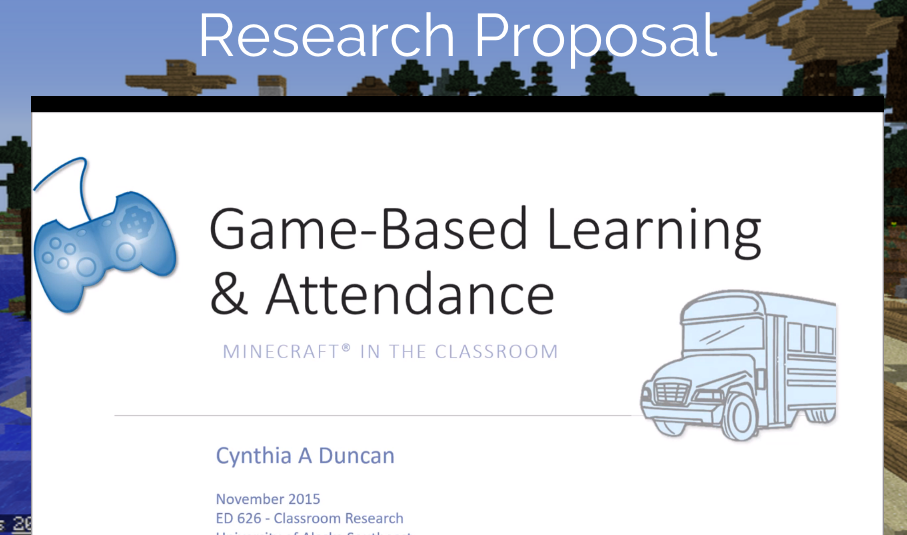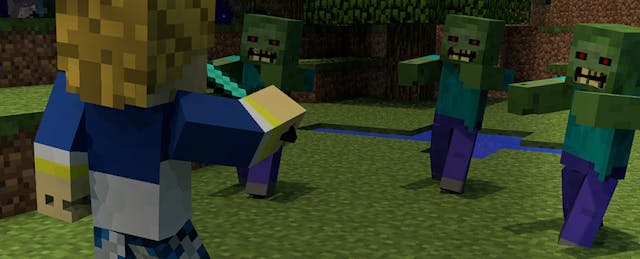It’s important to keep kids engaged in their learning, but how do we accomplish something that seems so abstract? Part of the solution has to do with making learning irresistible, and in my classroom, learning is driven by curiosities and interests. My students are 21st century students. It doesn’t matter that they are only second graders, and it doesn’t matter that they live on a small island in Alaska. I can motivate my students to learn by tapping into their interests.
And what are my second graders interested in, exactly? Minecraft, of course.
With encouragement from a graduate program at the University of Alaska Southeast and support from my district, I discovered that I could successful using my students’ interest in Minecraft to engage them in all kinds of learning—learning that went beyond a screen. But that wasn’t all. During this time, I also began to notice the positive effect Minecraft was having on attendance.
After conducting a classroom research study on game-based learning, I realized that I could strategically use Minecraft to improve attendance. When I incorporated Minecraft into my mornings, the number of unexcused absences and tardies were cut in half. Students didn’t want to miss any school.
Now, I know what you’re wondering. Minecraft? Attendance? How did I do it? And more importantly, why did it work?
Step 1: Doing the Research and Creating “Morning Craft”
The whole process began with a classroom Minecraft research project. This qualitative action research study examined the relationship between game-based learning and truancy in an elementary classroom. During this study, I looked for patterns in attendance behavior when Minecraft was played. The results? The data revealed positive changes in school attendance and engagement.

Prior to the study, I had been using Minecraft to enrich my students’ learning, but I hadn’t put much thought into the time of day I was using it. However, after the study, I realized that the morning was a great time to use the “sandbox game” because it was a great motivator—it got students to school and got their brains thinking right away.
Which my research in tow, I created Morning Craft, which is a simple reference to the “crafting” students would be doing in Minecraft at the very start of the day.
After I devised Morning Craft, I informed my students of the specifics:
- Morning Craft only lasts for the first thirty minutes of the school day
- If students arrive late, they miss part or all of their Morning Crafting time, depending on how tardy they are.
- Morning Craft is not an everyday thing—in fact, Morning Craft can be unpredictable, which encourages students to be on time every day.
Step 2: Crafting With a Purpose
When I first began Morning Craft, I had several days of Morning Craft in a row to test it out. But following, I started to spread these days out. In order to use my Crafting time strategically, we focused on projects. At the beginning of the initiative I chose projects students could jump into without much direction. That way, they could get as much out of the thirty minutes as possible.
However, I also wasn’t afraid to mix it up once in awhile. For example, I added hands-on making and coding activities to teach balance and enrich student learning. Here’s an example: We’ve used our Morning Craft time to building computational thinking with Minecraft Hour of Code by Code.org. And you never have to stop there—the opportunities for multidisciplinary learning are endless.
Step 3: Opening Up to My Classroom to Parents and Other Observers
Early-morning Minecrafting didn’t just excite the students about getting to school on time—it also engages the parents, who in many cases are the transporters. So, I invited parents, administrators and others in the community to watch our 21st century learning in action, as I felt like it was my job as an educator to help people understand the benefits of game-based learning.
It is important to show others how incorporating Minecraft into the classroom can be a great way for students to learn through active engagement in the curriculum. Being proactive and open from the beginning has helped me gain support and reduce misunderstandings—and that way, students can keep Morning Crafting.
Step 4: Thinking Outside the Box
Many schools around the country already recognize the interest students have in Minecraft, and some even hold after-school clubs devoted to the program. But based on the results I have seen in my classroom, perhaps schools should consider adding before-school Minecraft clubs.
In fact, my Morning Crafting practices are starting to spread to other classrooms in my school and beyond. I feel like I have unlocked a treasure chest with Minecraft and as an educator it’s my job to share the wealth, and I hope educators find success like I have. In addition to mentoring teachers, I recently presented the benefits of using Minecraft to educators from around the state at the Alaska Math and Science Conference. I also use a website I created to inspire teachers to use Minecraft—check it out here.
If you’re still on the fence about this, think to yourself: Are you more motivated to work on something you find enjoyable or interesting? Are you more likely to put in extra time and effort on tasks you find engaging? For most of us the answer is, yes—our achievement is driven by our interest. This is true even for children. Students who lack an interest in their education are at risk to become disconnected from school. And this disengagement can lead to poor attendance, amongst other things.
Don’t succumb to that disengagement. Morning Crafting has shown me that Minecraft can be used as an effective strategy for improving attendance, and it is time schools think outside the box and look to edtech tools as intervention programs.
Minecraft just might be the powerful intervention tool you and your school have been looking for.


